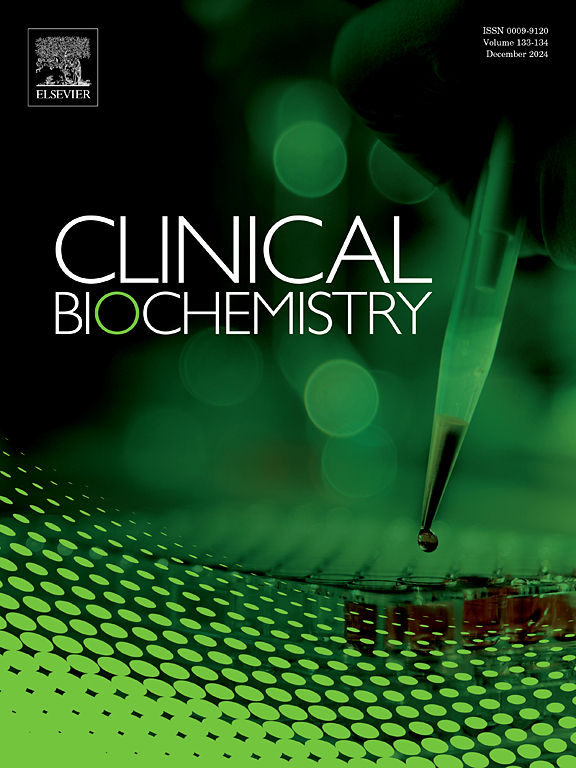Wide-range and high-throughput quantification of anamorelin in human plasma using ultra-high-performance liquid chromatography coupled to tandem mass spectrometry
IF 2.1
3区 医学
Q2 MEDICAL LABORATORY TECHNOLOGY
引用次数: 0
Abstract
Objective
Cancer cachexia is characterized by weight loss, muscle mass loss, and reduced food intake. Anamorelin is a ghrelin receptor agonist approved for the treatment of cancer cachexia. In this study, we established and validated an assay for quantification of anamorelin in human plasma.
Methods
For quantification of anamorelin, samples were pretreated with solid-phase extraction and analyzed by ultra-high performance liquid chromatography coupled to tandem mass spectrometry (UHPLC-MS/MS). This analytical method was validated in accordance with the Food and Drug Administration (FDA) bioanalytical method validation guidance. We used the established assay to quantify plasma anamorelin concentrations in five patients with cancer cachexia treated with anamorelin.
Results
The validation results of this assay method met the acceptance criteria recommended by the FDA guidance. Within-batch and batch-to-batch precision at the lower limit of quantification and three quality control levels were within 6.20 % and 6.55 % coefficient of variation, respectively. Within-batch and batch-to-batch accuracies ranged from −2.58 to −1.33 % and −3.78 to −1.69 %, respectively. Recovery rates and matrix effects corrected by internal standard were 82.7–84.2 % and 102.7–104.6 %, respectively. Using the established assay with a calibration range of 0.1–2500 ng/mL, plasma anamorelin concentrations were successfully quantified in all 15 plasma samples from 5 patients with cancer cachexia.
Conclusions
We established and validated a method to measure plasma anamorelin concentrations using UHPLC/MS-MS combined with SPE, and successfully applied the novel method to measure plasma anamorelin concentrations in patients with cancer cachexia. By measuring plasma anamorelin concentrations in large scale studies, the established quantitative method is expected to contribute to the pharmacokinetic study of anamorelin.
超高效液相色谱-串联质谱联用技术对人血浆中的阿纳莫瑞林进行大范围、高通量定量分析
目的癌症恶病质的特征是体重减轻、肌肉质量下降和食物摄入减少。Anamorelin是一种胃饥饿素受体激动剂,被批准用于治疗癌症恶病质。在这项研究中,我们建立并验证了一种定量测定人血浆中氨莫瑞林的方法。方法采用固相萃取法对样品进行预处理,采用超高效液相色谱-串联质谱法(UHPLC-MS/MS)对样品进行定量分析。该分析方法按照美国食品药品监督管理局(FDA)生物分析方法验证指南进行验证。我们使用已建立的测定方法来定量5例接受阿纳莫瑞林治疗的癌症恶病质患者血浆阿纳莫瑞林浓度。结果验证结果符合FDA指南推荐的验收标准。定量下限和三个质量控制水平的批内和批间精密度变异系数分别在6.20%和6.55%以内。批内准确度和批间准确度分别为- 2.58 ~ - 1.33%和- 3.78 ~ - 1.69%。内标校正后的回收率为82.7% ~ 84.2%,基质效应为102.7% ~ 104.6%。采用所建立的校准范围为0.1-2500 ng/mL的检测方法,成功地定量了5例癌症恶病质患者15份血浆样品中的血浆氨莫瑞林浓度。结论建立并验证了UHPLC/MS-MS联合固相萃取(SPE)测定血浆anamorelin浓度的方法,并成功应用于癌症恶病质患者血浆anamorelin浓度的测定。通过在大规模研究中测量血浆anamorelin浓度,建立的定量方法有望为anamorelin的药代动力学研究做出贡献。
本文章由计算机程序翻译,如有差异,请以英文原文为准。
求助全文
约1分钟内获得全文
求助全文
来源期刊

Clinical biochemistry
医学-医学实验技术
CiteScore
5.10
自引率
0.00%
发文量
151
审稿时长
25 days
期刊介绍:
Clinical Biochemistry publishes articles relating to clinical chemistry, molecular biology and genetics, therapeutic drug monitoring and toxicology, laboratory immunology and laboratory medicine in general, with the focus on analytical and clinical investigation of laboratory tests in humans used for diagnosis, prognosis, treatment and therapy, and monitoring of disease.
 求助内容:
求助内容: 应助结果提醒方式:
应助结果提醒方式:


